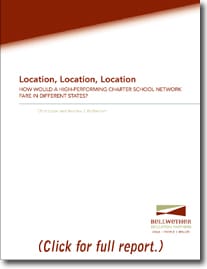 As it turns out, success in growing
charter-school networks is about three things: location, location, and
location. This report from Bellwether Education Partners speaks to questions of
the scalability and financial stability of charter schools; it examines the
hypothetical financial health of a single charter network, Aspire Public
Schools, if it took up shop in any one of twenty-three states instead of its
current home in California. The analysis indicates that, in eighteen out of
twenty-three jurisdictions studied, Aspire would be more financially
sustainable, enjoying an average of $1,410 in additional surplus funds per
student. In D.C., Aspire would receive $6,383 more per pupil. In only three
states (Idaho, Colorado, and Arizona) would Aspire operate under a deficit. (In
Ohio and North Carolina, the operating costs would be comparable.) Admittedly,
the paper is a thought experiment rather than a full-blown financial
analysis—it relies heavily on the recent Ball
State study of inequitable charter-school financing and on some assumptions
about cost differences between California and other states. Noting the gravity
of these assumptions, the results of this analysis are still powerful. There is
no denying that certain states are much more charter-friendly than others. As
such, expect to see robust expansion of charter-school networks only in states
with favorable financing landscapes, with CMOs in states with weaker financing
just limping along.
As it turns out, success in growing
charter-school networks is about three things: location, location, and
location. This report from Bellwether Education Partners speaks to questions of
the scalability and financial stability of charter schools; it examines the
hypothetical financial health of a single charter network, Aspire Public
Schools, if it took up shop in any one of twenty-three states instead of its
current home in California. The analysis indicates that, in eighteen out of
twenty-three jurisdictions studied, Aspire would be more financially
sustainable, enjoying an average of $1,410 in additional surplus funds per
student. In D.C., Aspire would receive $6,383 more per pupil. In only three
states (Idaho, Colorado, and Arizona) would Aspire operate under a deficit. (In
Ohio and North Carolina, the operating costs would be comparable.) Admittedly,
the paper is a thought experiment rather than a full-blown financial
analysis—it relies heavily on the recent Ball
State study of inequitable charter-school financing and on some assumptions
about cost differences between California and other states. Noting the gravity
of these assumptions, the results of this analysis are still powerful. There is
no denying that certain states are much more charter-friendly than others. As
such, expect to see robust expansion of charter-school networks only in states
with favorable financing landscapes, with CMOs in states with weaker financing
just limping along.
|
Chris Lozier and Andrew J. Rotherham, “Location, Location, Location: How Would A High-Performing Charter School Network Fare in Different States?,” (Washington, D.C.: Bellweather Education Partners, 2011). |
